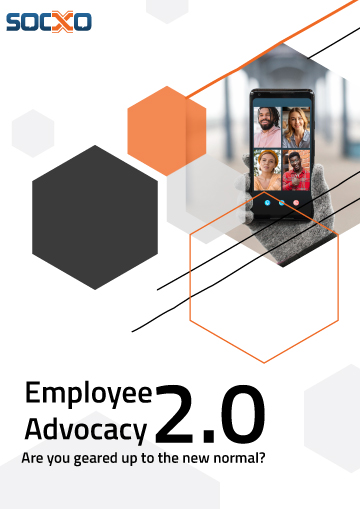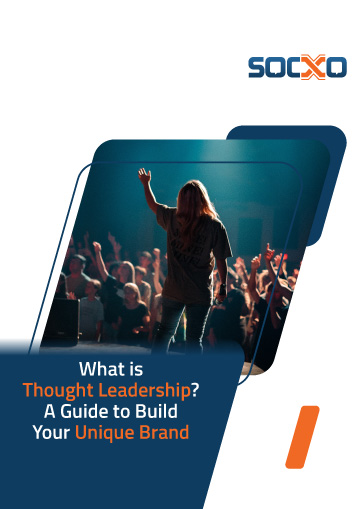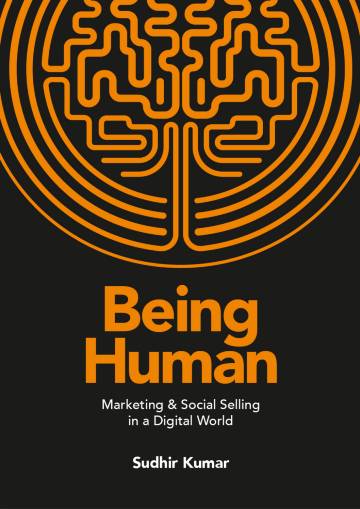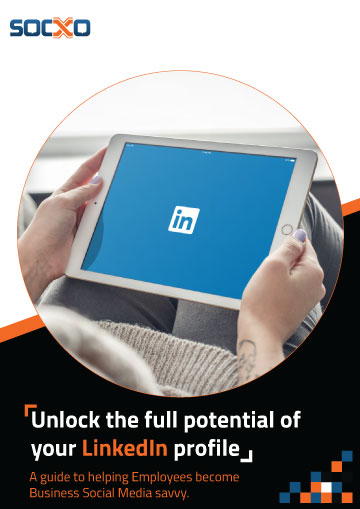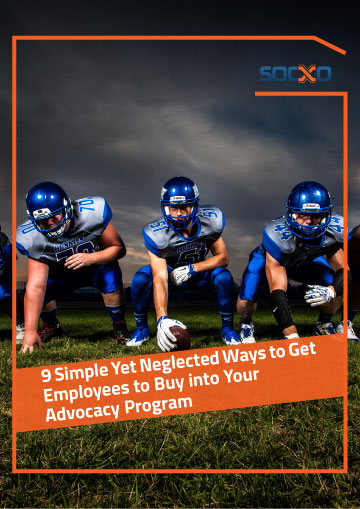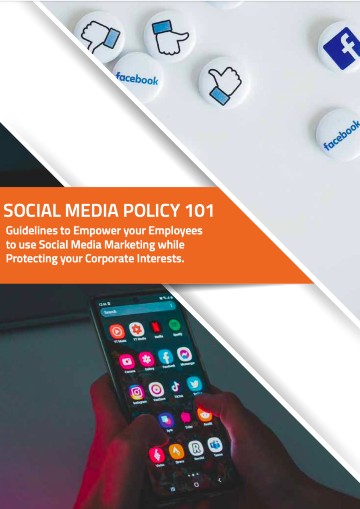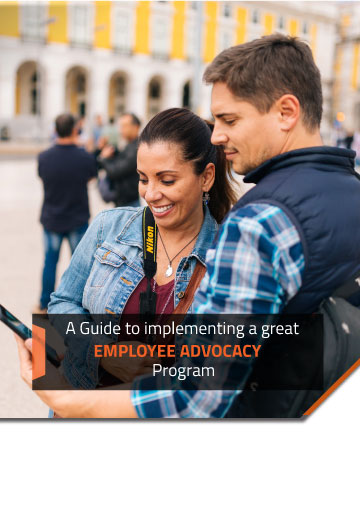
Introduction
Employee advocacy is no longer a mere string of corporate jargon. Today, it has become an active strategy with realistic business goals. While the traditional methods of marketing already work well in gaining consumer favour, it is the word from an employee of a brand that does the trick. Let’s look at employee advocacy mistakes that brands commonly make and some examples of organizations that did employee advocacy well.
Edelman seconds this opinion with its report that reveals that employees are the key to rebuilding public trust in brands and taking a brand along the path of growth. People are psychologically inclined to trust a fellow human rather than an email or SMS that’s incapable of expressing itself.
Forbes recently conveyed that brand communications shared by its employees go 561% further than the brand sharing through its channel.
These are a couple of reasons why employee advocacy is significant today. Letting your brand spokespersons share company news with the consumers is an excellent way to release first-hand, verified information to the public. However, as optimistic as this sounds, there are certain pitfalls that you need to avoid while adopting this approach. Implementing employee advocacy wrong can generate results and impact that is counterproductive and undesirable – sometimes even unprecedented.
Index:
- What is Employee Advocacy?
- 10 Common Employee Advocacy Mistakes to Avoid
- 6 Great Examples of Employee Advocacy
- Conclusion
What is Employee Advocacy?
Employee Advocacy is the approach to marketing where select employees of an organization are actively involved in promoting the brand, its culture, products, news, and media authorized by the administrators. Imagine Tesla sharing information about its latest launch compared to Elon Musk announcing it himself – which would be more inclined to believe and follow? Employee advocacy can be a human touch behind marketing, an internalized approach that delivers a better promise to the consumer that they can easily trust.
One of its employees’ messages about a brand has a higher impact than brand communication itself:
- Multiplying the brand reach by sharing the message on Employee networks.
- The brand content shared through an employee’s social channels is more believable by the public, thus holding more weight.
- Being an employee of the brand, vouching for its products and services will get more consumers on board to try them as it acts as a recommendation.
Employee advocacy brings more benefits to an organization than imaginable. Some of the major ones are:
- Better brand awareness, because employee networks help in amplifying messages.
- Creation of a more comprehensive sales network by reaching newer consumer pools.
- Opening up more communication channels with your consumers through utilizing the employee network.
With that said, it is important to note some common pitfalls to avoid.
10 Common Employee Advocacy Mistakes to avoid
The idea of employee advocacy takes a reasonable amount of time to yield results after implementation – and that too, only when it’s implemented and executed right. Thus, it helps to avoid the following common mistakes in advance to build a strong employee advocacy strategy.
Rushing Into it All Guns Blazing
The revolution of employee advocacy at your organization doesn’t need to begin at full throttle. Instead, this strategy needs to evolve organically, with a handful of employees advocating for the brand at any given time. Onboarding a hundred hands to start communicating doesn’t work – the move must be voluntary. Think of it this way: wouldn’t your consumers be overwhelmed seeing half your employees talking about the brand simultaneously?
Ask your employees if they wish to speak for the brand; deploy only a few from among these volunteers.
It is essential to understand the fundamentals of employee advocacy first before getting your employees to sign on for it. Advocacy needs to be voluntary to affect the posts the spokespersons make positively. It counteracts the objective of your employee advocacy program when your spokesperson interferes in the matter.
Consider this scenario: You cannot expect an employee of considerable influence and weight in your organization to diligently advocate on social media if he doesn’t prefer being on social networks. It is a matter of choice – ask for employee willingness to contribute to the brand awareness campaign in this manner. An employee who signs on voluntarily would garner greater attention among the public than the one who was coaxed into it.
Creating Echo Chambers
Employees tend to feel a sense of achievement after posting about the brand. However, enlisting too many volunteers for the job before aligning the number of employees required for sharing the content soon spins out of control once when the posts are ready. More often than not, all these “representatives” end up talking about the same topic and often on the same channels.
When too many voices of the brand are iterating the same information, it’s called an Echo Chamber. As a result, it isn’t significant and costs your organization valuable consumer engagement.
Another drawback of echo chambers is losing weight in the information shared. One of the primary purposes of reaching out to consumers is to initiate a conversation. When employees lack in-depth knowledge or ownership of the subject being talked about, the brand loses its credibility each time. Not only does this cut short all possible and meaningful exchanges with the public on the subject, but it also works to harm the image of your brand.
It works to assign topics to employees that they have the knowledge and resources to discuss with customers.
Expecting a Miracle
Employee advocacy is merely a strategy. Without all its cogs, gears, and mechanisms of implementation in place, it won’t work. Consider this scenario: if your organization is stoic, constantly grapples with low employee engagement, has undefined, scattered or nuclear brand culture, or minimal team interaction, then employee advocacy won’t miraculously fix all of this and engage your consumers.
Before adopting a tool that banks on the human capital of your resources, you need to thoroughly assess the quality, engagement, and satisfaction levels of this human capital. Forcing employee advocacy onto your employees would generate apathy towards the brand and may work further to disengage your workforce.
First, understand what your employees think about the brand before getting them to vouch for it on public media. Assess their level of comfort and willingness to do so. If the employees don’t hold the brand in very high regard, getting them to advocate for it would essentially be a sketchy attempt at pushing more laundered content to the consumers. This isn’t what employee advocacy is about; this is the exact antithesis.
Being too Trusting of The Existing Mechanism
To synchronize public media content sent to respective employees, a centralized system or a protocol needs to be in place. It is not safe to bank on things playing out by themselves. There are many roadblocks in traditional methods that hinder effective employee advocacy:
- Emailing pre-set content to various employees is the perfect recipe for creating echo chambers.
- Employees are busy people. It is easy for them to miss the broadcast email and completely forget to post on time.
- Mechanical treatment of the posts, since the employees aren’t interested in getting to know what the post actually contains.
There are just too many inefficiencies inherent in letting employee advocacy run itself without proper, dedicated governance. One way to ensure that employees actively contribute to the posts (creatively and conceptually) and that they own the content once it’s posted is to have a centralized tool. A slew of employee advocacy tools is available that condense every aspect onto a single platform, making it highly convenient to coordinate and create better content.
Forgetting too Early
The success of an employee advocacy campaign banks on consumer engagement. If that’s not happening, no matter how many posts or content you create, it will all have been for nought. You may have created the perfect post, coordinated on the right employee engagement tool, got the whole team on board, and done exhaustive research for it; it may still not perform as expected.
The key is to create content that sparks interest among consumers and has a call to action that incites some interaction with the person who has posted. Unless that happens, the post is just another drop in the ocean.
Avoiding information inundation is one way to sidestep this hurdle. Initially, try creating catchy, crisp posts that get the consumers talking. Build on the conversation by replying to every comment. You may let it play out by itself when it catches momentum, depending on the strategy advised by the administrators.
Remember that it doesn’t work to get too many fingers typing over the same thing. Instead, get one person to represent posts or use another way that works to maintain the cohesivity of your post.
Creating Volume Instead of Value
Many organizations misinterpret posting to social media as something that’s done several times a day by a certain number of employees and repeated the next day with a new set of employees. This doesn’t make sense. Think about it this way: the social network is already inundated with high volumes of data – by other brands amongst which are your competitors as well – how is your content making a splash if it doesn’t carry any weight?
Merely publishing loads of content online doesn’t create the desired effect. It is important to think hard about creating content that holds sway in the online world. Get an influential person to talk about your brand or a high-level employee to post content through his network.
You can add value to your posts in many ways:
- Professionals talk in-depth about a subject in the niche or join an ongoing conversation with their input.
- The C-suite officials speak out on a social cause or announce a brand initiative to contribute to the upliftment.
- Starting quizzes with some incentive for the participants.
- Seeking votes/polls / public suggestions for an upcoming product, done by professionals from the product development team.
Trying to Control Everything
If your organization decides to adopt an employee advocacy program, the chances are that trustworthiness of participants is already established. However, certain administrators still try to control and monitor every post that goes out from the channels of the spokespersons.
This does two things:
- Establishes in the spokesperson’s mind that he is not good enough to create responsible posts.
- It takes away from the intrinsic value of the post that would have made a better impact when not vetoed/modified/controlled by administrators. Spokespersons, too, sometimes need complete autonomy for individual posts where the publishing authority can’t effectively understand the subject matter.
To help your spokespersons understand the gravity of the matter, it is essential to guide them towards the right way to publish posts while being considerate and trusting enough of their position, intelligence, and interest in the brand. It is a tightrope to walk on, but a necessary one: employee advocacy needs to retain its essence. Being overly controlling of the content would be another form of brand communication, only through a different channel.
Preserve the sanctity of employee posts by letting a free hand and imposing control only when you discover any objections.
Playing it by Instinct
At an organizational level, not having things planned out in detail can spell disaster. The same applies to employee advocacy in place. In addition to seeking volunteers for the program, it is essential to plan out the following aspects:
- What do your employees need to be talking about?
- Which channels do they need to say it on?
- What information is OK for sharing, and what isn’t?
- Whether it is alright to name or tag other people in the posts?
- How frequently do they need to post, and by what time?
- What attributes must the posts carry? Any tags, hashtags, logos, etc.
Planning out everything in detail helps the posts go out on time, through the right professionals, to the right crowd, with fact-checked information and regular follow-ups. It also helps maintain cohesivity across communications, no matter who is posting.
It helps to have a protocol and framework in place that helps give direction to the employees regarding the starting point; additionally, it also helps remove errors going on public media to a great extent. Try your best to avoid employees posting haphazardly on the public media – it could lead to unprecedented information leaks or, worse, unintended offence.
Ignoring Internal Operations
Employee advocacy is a form of inbound marketing. There has to be enough internal buzz within the organization regarding this method before the same emotion can be expressed outward to the public. It is essential to have a preparatory phase in your organization that familiarizes your employees with what your organization is about to undertake.
There are ways to create a buzz amongst the ranks; one effective method is the gamification of the whole deal. For example, introducing an interactive activity over the employee advocacy tool for volunteers to participate in gets the people interested in knowing more about this mode of marketing.
Additionally, it is equally essential to plan out the groundwork for this marketing operation to be a success – first internally and second, externally. A great way to assess employees responsible for this initiative is to experiment with employee advocacy using a smaller team to see how it pans out. Make tweaks based on the results achieved before launching the campaign across the entire organization.
Your employees need to understand this campaign inside and out to generate any engagement from it. Ensure that every participant understands employee advocacy.
Absence of Tracking and Analytics
Every marketing campaign is set to generate a return on investment. By tracking the campaign and analyzing the numbers about its key performance indicators, organizations come to know whether or not the strategy worked.
The same concept applies to employee advocacy as well. Tracking the progress your posts are making online is a great way to assess the success or failure of your campaign. There are certain KPIs that you can track – although indirect – that can give you an idea of how each post is performing and whether or not it is working the way you expected.
- Tracking employee engagement through survey results.
- Tracking consumer onboarding by counting referrals, registrations, sign-ins, etc.
- Analysing the traffic volume changes on the website or social media channels upon the launch of the program.
- User activity.
- Subtle changes in other marketing campaigns, like changes in CPC, click-through rates, email-opening rates, etc.
- Interaction on social media posts, like comments, shares, likes, reposts, etc.
If you look closely, there are a lot of indicators that can tell you how well a post has performed on public media and whether or not it is generating any returns for your brand.
6 Great Examples of Employee Advocacy
Employee advocacy isn’t the simplest thing to get right in the first go; it is continuously implemented with repeated tweaking and improvement to make it work. However, a few companies got it right and are reaping its benefits today.
EA Sports
EA Sports is a multinational outfit, with offices spread over 30 geographical regions and more than 20,000 employees. The sheer scale of this company made it difficult to create a cohesive company culture and keep the employees entertained.
For its employee advocacy program, EA Sports launched the “EA Insiders” – an initiative to connect employees better, engage them in exciting games and promote healthy competition amongst each other. Not surprisingly, within months of its launch, employees sent the managers some great feedback about the program.
Through EA Insider, the participants generate tens of thousands of shares on social media every month; there are certificates for joining the program and participating in games or events; rewards for wins in competitions, and much more.
Dell
Dell, the tech giant, is one of the earliest organizations to recognize the importance of sentiment and employee empowerment. However, with the kind of growth the company was experiencing, it was becoming harder to centralize the employee advocacy structure.
The current employee advocacy design strictly focuses on two significant aspects:
- To get the top-level executives to talk about the new programs, technology, events, launches – anything – since their inception. When these employees give insight to the public about what’s coming, it gains more traction.
- To give employees a free hand on the informative content they wish to share. Dell’s administrators made it clear that 80% of the content shared needs to be highly informative, while 20% could be about the company.
Dell hit a gold mine by making it more about content quality and less about company marketing.
Genesys
Genesys is a global technology company and perhaps one of the first organizations to understand the importance of social media in employee advocacy programs. However, they recognized that while social media tools for employee advocacy were vital in keeping things organized, they were not enough.
They taught the practice of using employee advocacy in their sales teams, which were essentially scattered and remote. The main focus was on how every sales professional is unique in their skills; Genesys decided to harness that and allow social selling for professionals who preferred it.
This helped them create an open, creative environment for sales representatives and drove the bottom line figures towards significant improvement over the years.
Kelly Services
Kelly Services is a unique staffing agency that utilizes employee advocacy to achieve professional connections and assist organizations in hiring the right people for the job.
It is understood that LinkedIn profiles hold great importance in the world of professionals for making meaningful connections. Kelly Services, familiar with the fact that they had a vast base of employees who could leverage social media, decided to catalyze these connections using employee advocacy. By completely overhauling their marketing strategy by bringing social media into the equation, Kelly Services got the message out that they were active in the recruitment world, had a good base of talent, and could provide relevant, qualified connections on LinkedIn. This has made all the difference.
Starbucks
This well-known retail brand is famous for its white-and-green branding and coffee. However, there is one other thing it is known for: its employee advocacy. Starbucks believes in calling their employees their “partners.” This simple move has imbued more responsibility and accountability into their employees than publishing a rule book.
Additionally, Starbucks also provides each of its partners with a dedicated social media account where they could create relevant posts which, of course, follow their own social media guidelines; what this does is place immense confidence in your employees and consider them as responsible and accountable enough to post on behalf of their employer.
The social media accounts that Starbucks provides to its partners grow leaps and bounds daily. This is another excellent example of a successful employee advocacy program.
Reebok
Reebok is another brand that gives its employees a free hand in posting certain content on their Facebook and Instagram handles. Since this is a fitness and sports brand, Reebok encourages its employees to post content on their fitness and sports activities on their social media. They have an ingenious way to track each post – Reebok asks its employees to include specific hashtags in their posts which enables the company to keep track of what’s going out.
This is a great way of leveraging the company culture of fitness and health – when the employees themselves share their stories of good health, the customers are better convinced of the authenticity of a brand.
Conclusion
Employee advocacy isn’t a new concept; neither is it a miracle tool that can fix everything wrong with an organization. Instead, it is a practice of mutual respect between the employer and the employee, with a common goal to positively improve the business’s performance.
When appropriately implemented, employee advocacy has the power to bring an entire organization together, aligned towards the same purpose.
A few companies that implemented Employee advocacy and are reaping its benefits today are EA Sports, Dell, Genesys, Kelly Services, Starbucks, Reebok etc.
Employee Advocacy is the approach to marketing where select employees of an organization are actively involved in promoting the brand, its culture, products, news, and media authorized by the administrators.
Please avoid the following common mistakes: Rushing Into it All Guns Blazing, Creating Echo Chambers, Expecting a Miracle, Being too Trusting of The Existing Mechanism, Forgetting too Early, Creating Volume Instead of Value, Trying to Control Everything, Playing it by Instinct, Ignoring Internal Operations, Absence of Tracking and Analytics








